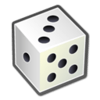Outline of probability
| Probability |
|---|
 |
The following outline is provided as an overview and guide to probability:
Probability is a measure of the likeliness that an event will occur. Probability is used to quantify an attitude of mind towards some proposition of whose truth we are not certain. The proposition of interest is usually of the form "A specific event will occur." The attitude of mind is of the form "How certain are we that the event will occur?" The certainty we adopt can be described in terms of a numerical measure and this number, between 0 and 1 (where 0 indicates impossibility and 1 indicates certainty), we call probability. Probability theory is used extensively in statistics, mathematics, science and philosophy to draw conclusions about the likelihood of potential events and the underlying mechanics of complex systems.
Introduction
- Probability and randomness.
Basic probability
(Related topics: set theory, simple theorems in the algebra of sets)
Events
Elementary probability
Meaning of probability
Calculating with probabilities
Independence
Probability theory
(Related topics: measure theory)
Measure-theoretic probability
- Sample spaces, σ-algebras and probability measures
- Probability space
- Probability axioms
- Event (probability theory)
- Elementary event
- "Almost surely"
Independence
Conditional probability
- Conditional probability
- Conditioning (probability)
- Conditional expectation
- Conditional probability distribution
- Regular conditional probability
- Disintegration theorem
- Bayes' theorem
- Rule of succession
- Conditional independence
- Conditional event algebra
Random variables
Discrete and continuous random variables
- Discrete random variables: Probability mass functions
- Continuous random variables: Probability density functions
- Normalizing constants
- Cumulative distribution functions
- Joint, marginal and conditional distributions
Expectation
- Expectation (or mean), variance and covariance
- General moments about the mean
- Correlated and uncorrelated random variables
- Conditional expectation:
- Fatou's lemma and the monotone and dominated convergence theorems
- Markov's inequality and Chebyshev's inequality
Independence
Some common distributions
- Discrete:
- constant (see also degenerate distribution),
- Bernoulli and binomial,
- negative binomial,
- (discrete) uniform,
- geometric,
- Poisson, and
- hypergeometric.
- Continuous:
- (continuous) uniform,
- exponential,
- gamma,
- beta,
- normal (or Gaussian) and multivariate normal,
- χ-squared (or chi-squared),
- F-distribution,
- Student's t-distribution, and
- Cauchy.
Some other distributions
- Cantor
- Fisher–Tippett (or Gumbel)
- Pareto
- Benford's law
Functions of random variables
- Sums of random variables
- General functions of random variables
- Borel's paradox
Generating functions
(Related topics: integral transforms)
Common generating functions
- Probability-generating functions
- Moment-generating functions
- Laplace transforms and Laplace–Stieltjes transforms
- Characteristic functions
Applications
- A proof of the central limit theorem
- Random sums of random variables
Convergence of random variables
(Related topics: convergence)
Modes of convergence
- Convergence in distribution and convergence in probability,
- Convergence in mean, mean square and rth mean
- Almost sure convergence
- Skorokhod's representation theorem
Applications
Stochastic processes
Some common stochastic processes
- Random walk
- Poisson process
- Compound Poisson process
- Wiener process
- Geometric Brownian motion
- Fractional Brownian motion
- Brownian bridge
- Ornstein–Uhlenbeck process
- Gamma process
Markov processes
- Markov property
- Branching process
- Markov chain
- Population processes
- Applications to queueing theory
Stochastic differential equations
Time series
- Moving-average and autoregressive processes
- Correlation function and autocorrelation
Martingales
See also
- Catalog of articles in probability theory
- Glossary of probability and statistics
- Notation in probability and statistics
- List of mathematical probabilists
- List of probability distributions
- List of probability topics
- List of scientific journals in probability
- Timeline of probability and statistics
- Topic outline of statistics